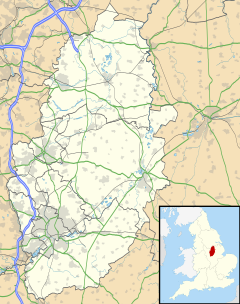Nottingham Guild Hall was built on Weekday Cross in Nottingham. Originally a hall for the merchant Guilds, it became the Court House and Town Hall of the Nottingham Corporation. The building was demolished in 1895.
| Nottingham Guild Hall | |
|---|---|
 Nottingham Guild Hall in 1741 by Thomas Sandby | |
| General information | |
| Location | Weekday Cross |
| Town or city | Nottingham |
| Country | England |
| Coordinates | 52°57′06″N 1°08′49″W / 52.951616°N 1.146813°W |
| Demolished | 1895 |
History
editWhen the merchants established a Guild to regulate trade they erected a Guild Hall on Weekday Cross. This building became the Court House and Town Hall when the borough had its own mayor and aldermen.
In 1726 Nottingham Corporation built a new town hall in the Market Place which became known as the Nottingham Exchange. The old town hall on Weekday Cross continued to be used alongside the Exchange and was refaced in brick in 1744.[1] The building was raised several feet higher,[2] and a new clock was provided by local clockmaker, John Wyld.[3]
The Guildhall was abandoned in 1877 with the opening of the new Nottingham Guildhall, and the old town hall was demolished in 1895 when the Great Central Railway built a tunnel with the portal just underneath Weekday Cross. The courts moved to a newly built Nottingham Guildhall on Burton Street. The clock was sold to Alderman Perry for £9 who installed it in his Boulevard Works on Radford Boulevard.[4] It was still being serviced by Cope's of Nottingham in the late 1970s.
This site is now occupied by the Nottingham Contemporary gallery.
References
edit- ^ A centenary History of Nottingham. John Beckett. Manchester University Press. ISBN 0719040019
- ^ The Old Guild Hall and Prison of Nottingham. John Potter Briscoe. 1895
- ^ Clock and Watch Makers of Nottinghamshire. Harold H. Mather. Friends of Nottingham Museums. 1979
- ^ "Sale of Nottingham Old Town Hall". Nottinghamshire Guardian. England. 17 November 1894. Retrieved 14 January 2023 – via British Newspaper Archive.
